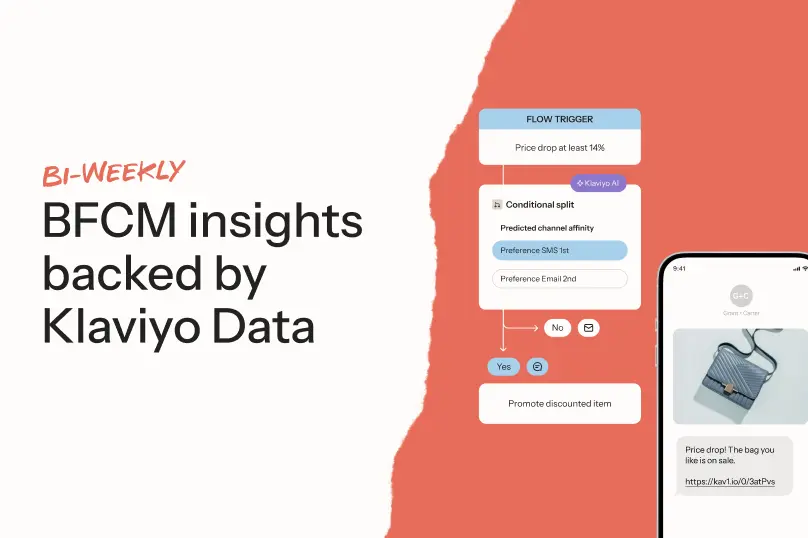Omnichannel vs multichannel: key differences and examples for B2C brands

Ever wondered why some brands feel seamlessly connected across every touchpoint while others feel scattered? The difference often comes down to how (and where) they engage with their audience. It’s not just about being everywhere—it’s about doing it in a way that feels like one conversation.
A multi-channel experience is disjointed, whereas an omnichannel strategy builds relationships with cross-channel conversations informed by unified customer data.
An omnichannel strategy meets your customers’ personal needs across every interaction—no matter where it happens.
With 1 in 5 consumers abandoning brands after a single negative experience, according to Klaviyo’s future of consumer marketing report, the stakes for getting this right have never been higher.
Omnichannel marketing: creating unified customer experiences
Omnichannel marketing is real-time orchestration across marketing and commerce channels—both physical and digital—powered by a shared customer profile and AI that adapts to each moment.
With omnichannel, customers experience an integrated, cohesive, and personalized journey, regardless of where or when they have touchpoints with your brand.
Why omnichannel marketing matters now
- Rising consumer expectations: Customers expect fast, personalized communication across every digital and physical touchpoint. According to Klaviyo’s aforementioned future of consumer marketing report, 74% of consumers expect brands to provide personalized experiences in 2025.
- Privacy transformations: Changes to privacy regulations are leading to a devaluation of third-party data. With more states enacting comprehensive privacy laws, brands need to invest in channels that function through zero- and first-party customer data instead.
- AI-driven personalization: Consumers now regularly interact with AI systems that remember their preferences and predict their needs. These expectations are translating to their shopping experiences as well.
Customers move fluidly from TikTok to your site to your physical store to WhatsApp support—and they expect brands to meet them there, in real time, with context.
Multi-channel marketing: what it is and why it’s no longer enough
Multi-channel marketing keeps your brand looking and sounding consistent across channels, but without connecting the data behind them.
Behind the scenes, these channels function as separate islands, each with their own isolated data repositories, performance metrics, and customer profiles.
Multi-channel marketing isn’t wrong, but it has some clear limitations:
- Fragmented customer experiences: If you’ve ever purchased an item only to get an email the next day with an offer for that same item, you’ve experienced multi-channel marketing. This disconnect extends beyond communication to pricing and promotions, and it can lead to frustration among shoppers who want access to the same offers across all channels.
- Limited personalization capabilities: Siloed data makes meaningful personalization virtually impossible. When you can’t follow a customer’s complete journey—from their email interactions to their in-store visits to their mobile app usage—you’re missing the full picture of their experience. This fragmented view prevents you from delivering the right message at the right time through their preferred channel.
Multi-channel marketing can still work in certain situations—we’ll cover when it makes sense later in this article. But in a world where consumers increasingly expect personalized, integrated experiences, the limitations of this approach may cost you in revenue and customer loyalty.
Key differences between omnichannel and multi-channel approaches
Now that you understand the big picture of omnichannel and multi-channel, let’s zoom in on how these marketing approaches differ.
1. Data integration approaches
Multi-channel marketing stores data in separate databases for each channel. Your email platform stores email engagement data. Your SMS platform holds data for SMS subscribers. Your point-of-sale (POS) captures purchase data from in-store sales. And all your customer data lives within these data silos. These disconnected tools require complex integrations that often break or sync too slowly to create cohesive experiences.
Real omnichannel marketing needs a different tech setup: a unified CRM that connects all your marketing and commerce tools, updating instantly as customers interact with your brand.
This connected setup lets data flow between touchpoints, so you can personalize experiences in real time—which is what makes omnichannel work.
Consider how a sportswear brand might approach price alerts for running shoes with an omnichannel strategy. Rather than broadcasting identical messages across all channels, they deliver notifications through each customer’s preferred communication method. So, customers who consistently open emails receive email alerts, while those who engage primarily via text get SMS notifications instead.
Without this integrated data foundation, the brand risks creating message fatigue and misses engagement opportunities by guessing which channel to use.
2. Customer journey mapping
Multi-channel teams optimize separate channels in isolation. Email teams focus on click rates, social media teams track engagement metrics, and retail teams measure foot traffic. While each channel may improve incrementally, the overall customer experience remains disconnected at transition points between channels.
Omnichannel strategy optimizes channels through customer lifecycle marketing. Rather than channel-specific metrics, teams map complete customer journeys from discovery to purchase and beyond.
Consider a fashion brand implementing true omnichannel journey mapping. Rather than separately optimizing their website for conversions and their stores for in-person sales, they create connections between these previously isolated touchpoints.
So, they might email in-store-only discount codes to online shoppers to bring people into physical stores. They may also alert local store managers about high-value items left in abandoned carts online.
3. Personalization capabilities
Multi-channel marketing typically offers basic audience segmentation within individual channels. Your email platform might segment subscribers by engagement or purchase history. Your SMS platform might group customers by response rate. Each channel delivers personalization based on limited, channel-specific data points.
Omnichannel personalization adapts messages in real time, across all channels. With access to unified customer profiles that house cross-channel behavioral data, preferences, and history, brands can deliver truly personalized experiences that meet customers where they are.
Consider a skincare brand with both ecommerce and physical spa locations. With an omnichannel approach, they can use geotargeting to promote brick-and-mortar spa services via email, but only to customers living near physical locations. An omnichannel approach would also make it easy to send aftercare tips based on the actual treatment someone received.
This approach creates a continuous feedback loop where in-person services inform digital recommendations, and online behavior shapes future in-store experiences—a level of personalization that simply can’t exist within the siloed approach of multi-channel marketing.
4. Marketing team structure
Multi-channel organizations typically structure teams around specific channels—an email marketing team, a social media team, an in-store team—each with separate goals, budgets, and performance metrics. These silos naturally lead to disconnected customer experiences.
Omnichannel organizations break down these walls. Rather than structuring around channel-specific teams, brands hire customer lifecycle marketers to break down different strategies for attracting, engaging, converting, and retaining customers across their entire journey. This integrated structure naturally produces more cohesive customer experiences.
When to use multi-channel vs. omnichannel
Not every business needs to implement a full omnichannel strategy immediately. Your optimal approach depends on your business size, customer base, industry, and resources.
Understanding when to implement each strategy can help you allocate resources where they’ll drive the greatest returns.
When multi-channel marketing makes sense
Sometimes, a well-executed multi-channel strategy is the right choice. Multi-channel approaches often work best:
- For smaller brands just starting to expand beyond a single channel: If your ecommerce store is established but you’re just starting to text subscribers rather than only emailing them, focus on excellence in each channel before tackling complex integration.
- When budget constraints limit investment in integrated technology: Quality execution across separate channels often beats poor implementation of omnichannel tools that exceed your current resources.
- For businesses with distinct customer segments that don’t overlap between channels: If your in-store and online customers have minimal crossover, the investment in unification might not deliver immediate returns.
- For temporary campaigns or limited-time promotions: If the complexity of full integration doesn’t justify the short-term benefits, it might not be the right time to implement an omnichannel strategy.
When to prioritize omnichannel marketing
Omnichannel marketing becomes essential in several scenarios:
- For brands with complex customer journeys spanning multiple touchpoints: When customers discover you on social media, conduct research on your website, visit your store, and complete their purchase via mobile app, you’ll need ways to send contextual messages to customers across all these touchpoints.
- When competing in markets where customer experience is a key differentiator: This can include brands that operate in luxury retail or premium hospitality. Here, customers expect personalized service that acknowledges their preferences and purchase history.
- When your data reveals customers are experiencing friction points in their journey: If customers browse online before buying in-store or check inventory on mobile while standing in your shop, they’re already behaving in an omnichannel fashion—even if your systems aren’t. Meet them where they’re at with an omnichannel strategy.
6 assessment questions to determine your readiness for omnichannel
These 6 questions serve two purposes: to identify whether you’re ready for omnichannel implementation and to highlight areas where your current multi-channel approach is falling short.
If yes, you have the data foundation necessary for omnichannel. If not, this visibility gap is your first challenge to address.
If not, this indicates a fundamental technical barrier to omnichannel implementation that you need to address before tackling other initiatives.
Teams organized strictly by channel often struggle with omnichannel implementation. Consider restructuring teams around customer segments or journey stages first.
Regular cross-team communication indicates cultural readiness for omnichannel, while siloed teams signal a need for organizational change before an investment in technology.
Legacy systems with poor integration capabilities may require upgrades before full omnichannel is possible.
Customer complaints about pricing discrepancies or lack of personalization across channels signal an urgent need for omnichannel solutions, regardless of your current technical readiness.
Your answers show where you stand and what to tackle first. The key is building omnichannel capabilities step by step—you don’t need to transform everything at once.
How Klaviyo B2C CRM powers true omnichannel experiences
Moving from multi-channel to omnichannel isn’t just a matter of strategy. It requires the right customer platform.
Klaviyo B2C CRM centralizes data from 350+ integrations into a single customer profile that updates in real time as shoppers interact with your brand across channels. This is how top B2C brands are implementing cross-channel orchestration, delivering personalized experiences via email, SMS, WhatsApp, mobile push, and physical stores.
FAQs
What is an example of a multi-channel marketing approach?
One example is a retailer that uses social media, email, and physical stores but keeps each channel’s data separate. Shoppers might receive duplicate offers because the brand doesn’t share information across channels.
Is Starbucks omnichannel or multi-channel?
Starbucks is widely viewed as an omnichannel brand. Their rewards app connects in-store purchases with online ordering, so people can earn and use rewards anywhere.
Is Walmart multi-channel or omnichannel?
Walmart invests in an omnichannel experience that blends in-store shopping with online ordering, store pickup, and local delivery.
Is IKEA omnichannel or multi-channel?
IKEA uses an omnichannel strategy by letting people browse inventory online, view products in augmented reality, and buy in-store or for pickup, all with a consistent brand experience.

Related content

Learn 5 ways to turn new holiday shoppers into repeat buyers using personalization, seamless returns, targeted outreach, and AI-driven customer experiences.

Learn what to include in your photography style guide to create consistent, on-brand visuals across your B2C marketing channels.

Shopping is about to hit its peak season. But this year’s surge will look different from those before it. Instead of impulsive buying sprees, shoppers are entering the holidays with a more deliberate mindset.